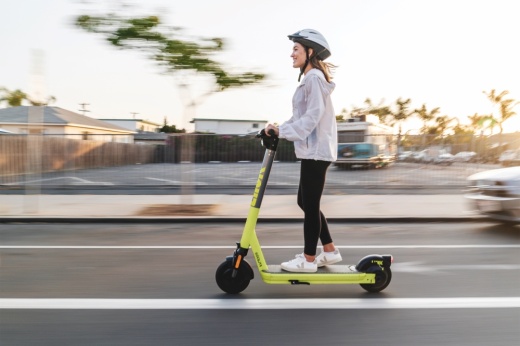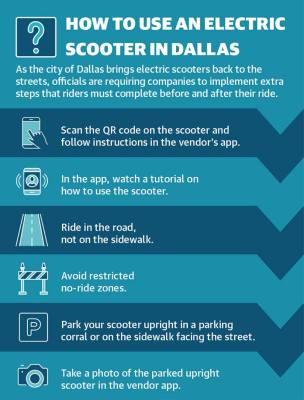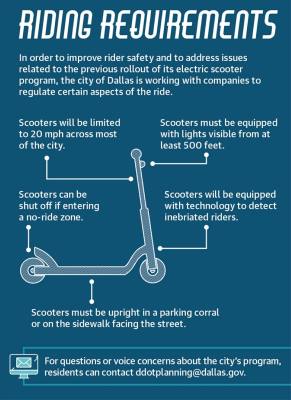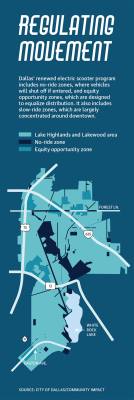Dallas City Council banned electric scooters from the city in September 2020 amid concerns about public safety with scooters being parked incorrectly, driving too fast and cluttering streets. In June 2022, the council approved new regulations for scooter usage, getting the city moving on reactivating its scooter program.
Jessica Scott, bicycle and micromobility manager for the Dallas Department of Transportation, said the new program is scheduled to roll out in the first quarter of 2023, once the city finalizes its contracts with scooter vendors and its data programming company.
As the city of Dallas looks to revive its electric scooter program, officials and vendors have proposed beginning with a fleet that includes:
- 1,350 Scooters to start the program
- 100 Seated scooters
- 45 E-bikes
- 5 Assisted scooters
- 1,250 Scooters and bikes each company could deploy eventually
“We live in such a car-centric society that requires people to be able to physically drive a car, afford a car, afford the insurance and maintenance,” Scott said. “Providing options for other modes of transportation makes everything in someone’s life more accessible. ... It just provides more choice and freedom for residents.”
City officials plan to evaluate the scooter program every 90 days, Scott said.
Positive evaluations, which city officials expect as they plan to work collaboratively with the companies, could allow scooter vendors to add 250 more scooters, up to a maximum of 1,250 scooters each.
The number of scooters could also be potentially lowered if they are not used often.
Austin officials said they saw success with their electric scooter program, which rolled out in 2018, through things like quick response times to regulation violations and clear designations for where and when scooters are allowed. Joseph Al-Hajeri, mobility demand program manager for the Austin Department of Transportation, said he believes Dallasites could embrace the program if the city’s scooter regulations are successfully implemented.
“Allow the industry to do what it’s supposed to do and work with the providers closely—don’t become their enemies—and really try to understand what the public is needing,” Al-Hajeri said.
Stricter regulations
Many of the issues the city of Dallas faced with its previous electric scooter program involved incorrectly parked scooters that cluttered sidewalks, Scott said. There were also a number of safety concerns in Deep Ellum and Uptown, including riders frequently on sidewalks. Despite some of the negative backlash the original program garnered, Scott said it was important for the city to reinstate electric scooters as a mobility option in Dallas.
Under the new program, electric scooters will only be allowed to operate from 5 a.m. to 9 p.m., and riders must be 16 years old or older. Whether rented from the city or privately owned, scooters will not be allowed in “no-ride” zones, which include sidewalks, trails, parks, plazas, or any roads with a speed limit of 35 mph or higher, Scott said. In no-ride zones, riders must dismount their scooters and walk the vehicles through the designated area. If they try to ride through a no-ride zone, their scooter will automatically shut off.
In addition to no-ride zones, the city will implement “slow-ride” zones, which will limit how fast scooters can drive. Riders will face a citywide speed limit of 20 mph, and slow-ride zones will reduce that limit to 10 mph, according to the city program’s website. Scooters will automatically slow down to the required speed when traveling through slow-ride zones.
White Rock Lake, Olive Shapiro Park, Flag Pole Hill Park, Norbuck Park and Tenison Park are among the more than 30 no-ride zones in the Lake Highlands and Lakewood areas. Slow-ride zones are mainly centralized in downtown Dallas, according to the city’s online map of the zones. Riders will receive a warning as they approach no-ride and slow-ride zones.
“We’re looking for this program to have structure, to have organization and to really be more usable by everyone in the city of Dallas,” Scott said.
With the previous program, electric scooters were deployed into any area of the city without regulations on how many scooters could be located in certain areas, Scott said. With the new program, scooter density will be managed by a regulation prohibiting having more than 25% of each vendor’s fleet—125 scooters—in high-activity areas of Dallas.
The scooter companies will be required to address sidewalk obstructions or misplaced scooters within two hours of a complaint, Scott said.
Advanced technology
Jamie Perkins, director of communications for Superpedestrian, said the company uses Vehicle Intelligence, a software that performs safety checks and detects things like tipped over scooters, she said. Other scooter companies use similar programs that immediately alert the company’s operations team to correct the issue.
Paul Ridley, Dallas City Council member for District 14, said that while he has confidence in the program’s new regulations, it will be impossible to tell how well they work until the scooters get rolling.
For example, if riders try operating electric scooters on sidewalks, the GPS technology is capable of shutting the vehicle down, Ridley said. However, he is unsure of how accurate that GPS technology will be in distinguishing a sidewalk from the street it runs alongside.
“It’s not uncommon for there to be great claims for the latest and greatest technology, but sometimes it doesn’t work out in practice like it’s been advertised,” Ridley said. “I’m optimistic that won’t happen, but we won’t know until we see how [the scooters] operate on the streets.”
Community members can voice concerns, questions or ideas about the electric scooter program by emailing the Dallas Department of Transportation at [email protected].
Managing riders
Some of the electric scooters, depending on the vendor, will have new programming to be able to detect a rider’s response time to traffic changes or turns, Scott said. That technology will be deployed especially during times when people may be drinking alcohol. If a rider appears to be inebriated in some way through slow response times, they would not be allowed to continue operating that scooter, Scott said.
All new users will be required to view training materials on how to operate electric scooters when they register to use a vehicle through the vendor’s app. Kelly Pierce, Dallas operations coordinator for Lime, said Lime riders will be required to take a basic knowledge test once out of every five times they open the company’s app to ensure that they know the rules. Scott added that each scooter vendor will be required to educate their users on how to properly use the scooters, how to properly park them and what rules they will be regulated by.
“We find that most riders actually want to do the right thing, so it’s sort of [a matter of] providing them the knowledge that they need to be able to do so,” said Jacob Tugendrajch, communications lead for Lime.
One of the challenges facing not just Dallas but any city with an electric scooter program is simply how young the industry is, said Perkins, the Superpedestrian representative. Shared electric scooter programs were not available before 2018, and many people—both riders and city officials—are not familiar with how to best use them, she said.
“Cities are all still learning what works for them, and riders are brand new all the time, too,” Perkins said. “One of the challenges there is that we’ve got a whole bunch of novices and amateurs out there who are all learning the city rules while learning how to ride the vehicle itself.”
Those who do not comply with all electric scooter regulations may face a fine of up to $200 from the city of Dallas, Scott said.
The costs of rides will depend on the vendor and time of day.
Improving micromobility
Dallas also plans to implement “equity opportunity” zones, which will be located in low-income areas of Dallas near other transportation options like Dallas Area Rapid Transit stations. Each scooter vendor will be required to deploy 15% of their fleet to equity opportunity zones to equalize distribution and usage across the city. The equity opportunity zones near Lake Highlands and Lakewood will be particularly focused in Vickery Meadow.
“You have a choice to walk or bike or scooter to work or the grocery store or the library or the bank—it just provides more choice and freedom for residents,” Scott said.
Of the Superpedestrian fleet, Perkins said the company is deploying 400 standard standing electric scooters and 100 seated electric scooters to Dallas. She said the seated scooters are suited to longer trips that may be more common in a geographically large city like Dallas and may better serve low-income communities without other transportation options.
Ridley, the District 14 council member, said the electric scooters will serve as a resource for people who need a mobility option for trips that are a mile or less. He added that having a micromobility option like electric scooters may also alleviate the pressure of limited parking spaces in dense areas of the city like downtown and Uptown.
“I would just ask [the community] to be patient with the rollout and see if we have adequately addressed their concerns from the initial rollout, and if they are still having problems, to alert the city,” Ridley said. “We at the city are open to feedback from our residents.”








